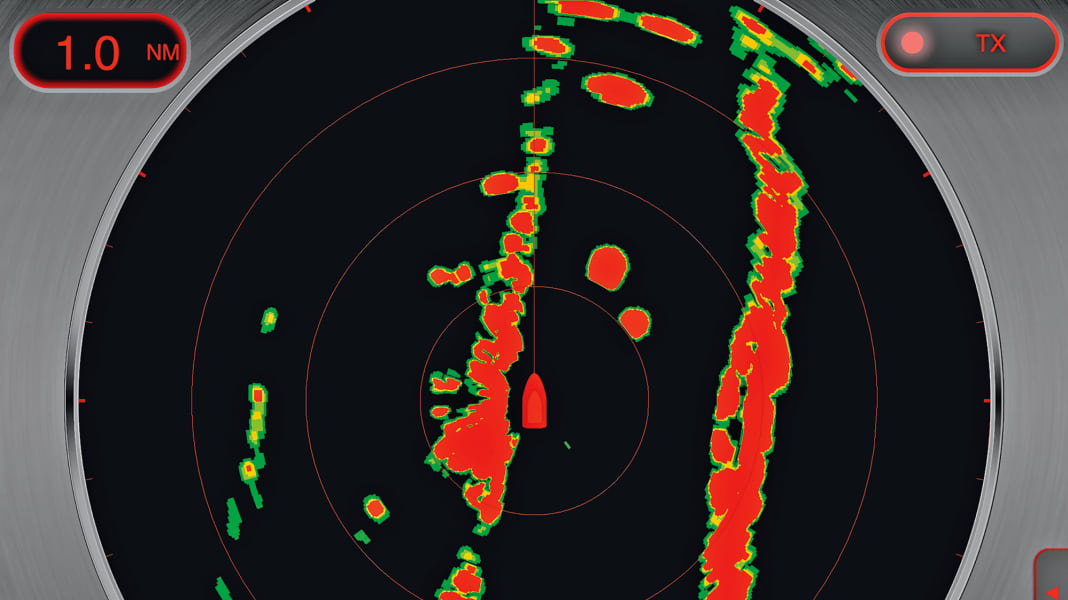
Night, poor visibility, a narrow fairway with unlit buoys and net buoys alongside - who wouldn't want a radar? Neither price nor power consumption are a major obstacle with the current devices: The radar antennas for the plotters in the test cost between around 1700 and 2400 euros. If you buy both together, you can get favourable packages from various dealers.
We have subjected the most modern models from the four major manufacturers of navigation electronics to a practical test. Furuno plays a special role here, as its radar is not dependent on a plotter from the same manufacturer as its competitors: It also works with navigation software on the iPad. Navico is the manufacturer of B&G, Simrad and Lowrance. The radar of these brands differs only in the imprint; the technology and price are the same for all three, and they can be interchanged. It should generally be noted that the radars do not work with all plotters from the respective manufacturers. Only the current series listed in the table are compatible.
Reach
The clear visual differences are of little practical relevance. All devices are suitable for yacht operation
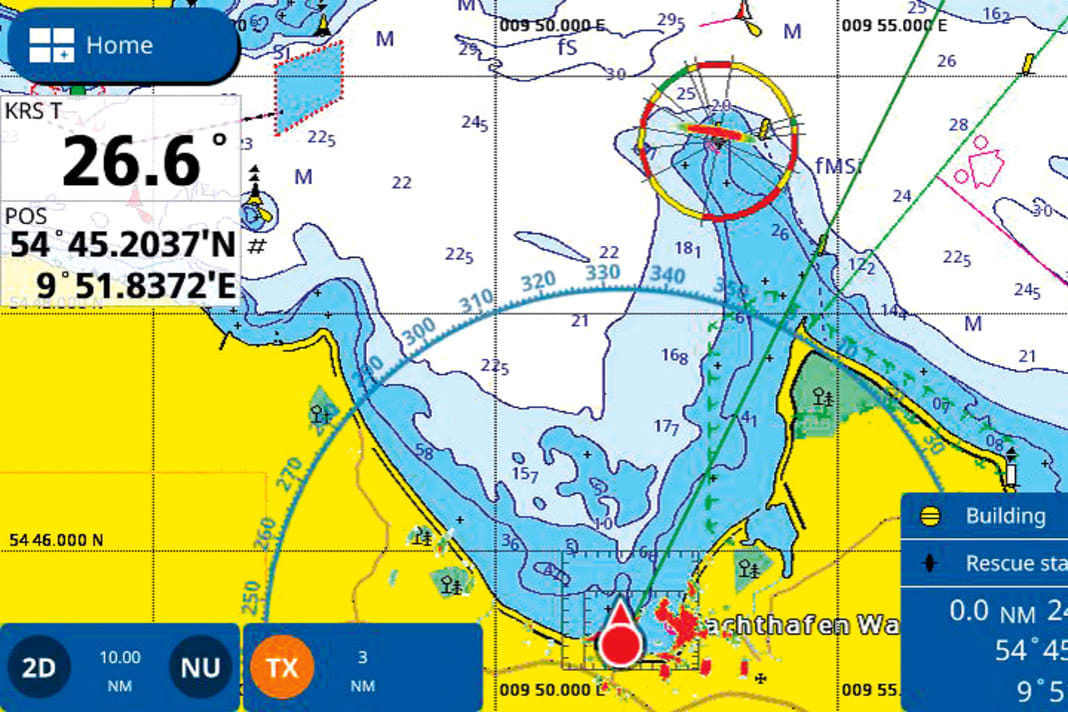




Technology
A radar emits a signal and displays on the screen the distance and direction at which echoes are received. The distance is determined from the time between transmission and arrival of the echo - similar to an echo sounder. For the direction, the antenna rotates and the image shows the echo in the direction in which the antenna is currently pointing. The radars tested differ fundamentally in the way in which the high-frequency signal is generated and processed.
Pulse radar
The classic method is a magnetron, which is basically an electron tube that directly provides high frequency with high power. It must be heated electrically and brought up to temperature before operation, which can take several minutes depending on the size of the device. The transmission power is several kilowatts, but it is only ever emitted in pulses lasting a few tenths of a microsecond - hence the name pulse radar. The shorter the pulses, the better the range resolution, but the weaker the echo. A very high transmission power is therefore required.
During transmission and shortly afterwards, the receiver cannot analyse any echoes. For this reason, the area of one pulse length of propagation time around the antenna cannot be used, this is referred to as a dead zone. Depending on the technology and the set range, this can range from a few metres to several miles.
Control with overlay
Seeing a lot does not necessarily mean seeing clearly. Only sharp echoes produce a good usable radar image
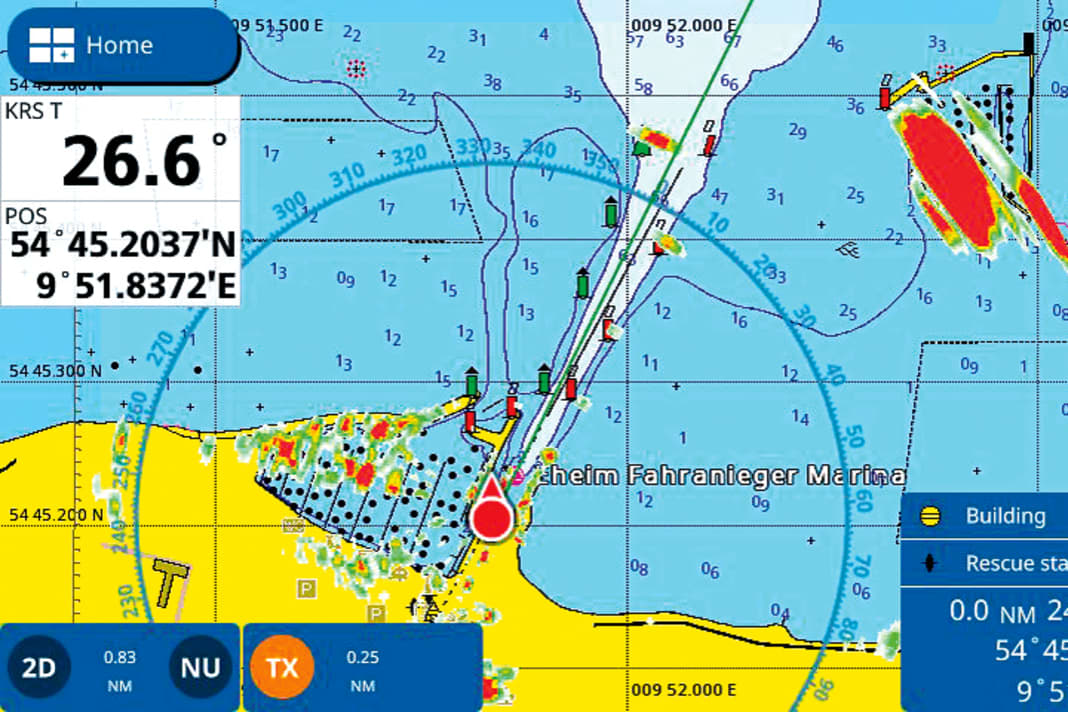




Pulse compression radars
Semiconductor radar (solid state) takes a different approach. The resolution in the distance is not achieved here by the shortness of the pulses, but by a constant change in the frequency of the transmitted signal. This enables the receiver to determine within an echo which section of the transmitted signal it originates from. The pulse itself can therefore be very long; significantly less transmission power is required to obtain a sufficiently strong echo.
However, the analysis itself requires a lot of computing power and complex technology: the entire energy of a long echo is mathematically projected onto the time of first arrival to create a sharp marker. Overlapping echoes are separated again. This technique is called pulse compression. Conveniently, the process automatically reduces interference such as rain or swell echoes and improves the sensitivity of the receiver.
Doppler effect
Pulse compression radars manage with transmission powers of between 20 and 40 watts. However, long pulses alone would again have the disadvantage of a large dead zone. For this reason, pulses of different lengths are usually transmitted in succession. Short pulses with little energy are sufficient for the close range, longer pulses with more energy to scan the greater distances. Another effect can be utilised by evaluating the frequency of the received signal: It is higher the faster a target approaches and lower when it moves away.
Mr Doppler recognised this connection. However, there is a lot of maths involved in separating the frequency shift caused by the Doppler effect from the pulse compression technology. This is called motion detection in naval radar and visually indicates after just one antenna rotation whether targets are approaching (red), moving away (green) or remaining at the same distance. To make these stand out from the other radar echoes, a sensible choice of colour is required. The two models with motion detection, Fantom and Quantum, offer a choice of eight different palettes. In contrast to automatic target tracking, Motion Detection does not determine the course or speed of a target; only the approach is decisive.
Close range in the harbour
Clear visualisation at short distances is more important than range - and a challenge for the devices, as the echoes have to be processed particularly quickly for good resolution
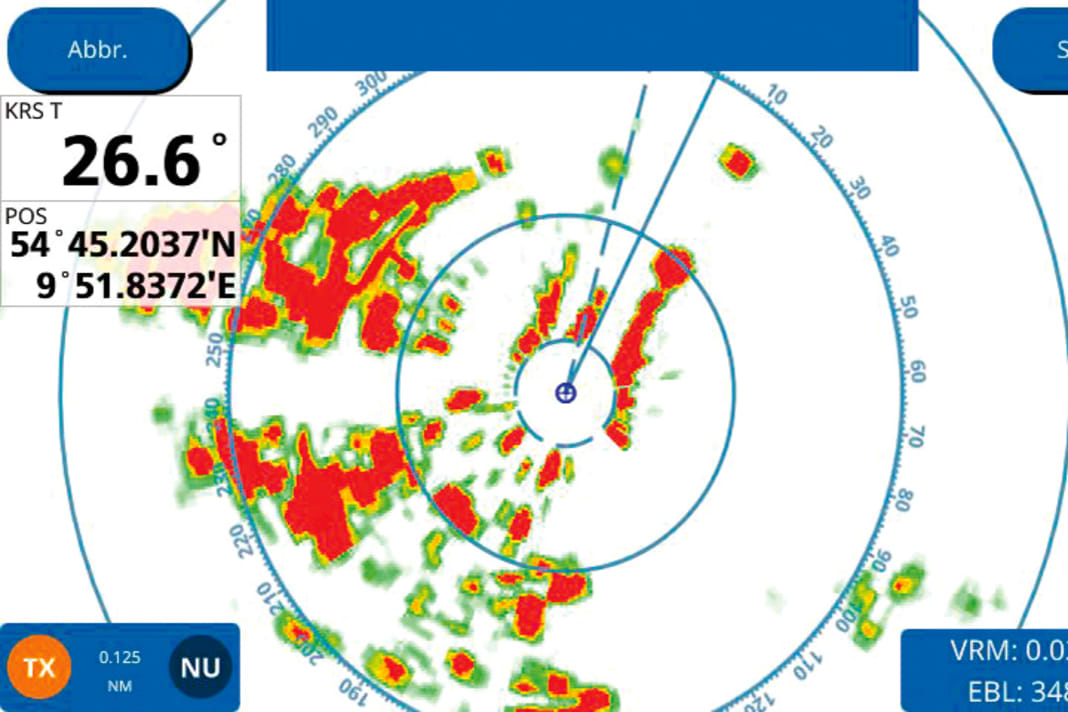




Furuno DRS4W
The only conventional pulse radar in the test. It works with a magnetron, hence the long start-up time of one and a half minutes until the device reaches stand-by mode after switching on the power supply. Only one power supply is required, all data communication takes place via WLAN. The current Furuno plotters from the GP series or iPad or iPhone can be used as a display device; two devices can be paired simultaneously. A main switch must be provided on board, as the radar naturally cannot be woken up from the completely off state via WLAN.
There is a button directly on the screen for switching between transmission and standby, both in the app and on the plotter. Furuno specifies a very conservative value of ten metres for the network range; in the test, the connection was stable over more than twice this distance. Furuno relies entirely on automatic operation for this device; the only adjustment option relates to rain clouding.
Application
Gain and sea clouding cannot be influenced manually. This is a huge advantage for inexperienced users: they cannot inadvertently render the radar image unusable by making unfavourable settings. It is always sufficient for navigation and collision avoidance. In situations with numerous strong echoes at close range, for example in front of a harbour, the automatic system mercilessly turns down the sensitivity. This makes the image appear quite empty at long distances - but you don't really need that in this case. On open water, all echoes can then be seen again at a great distance.
A printed manual in German is supplied with the radar. This makes installation and operation on the iPad easy. The description of radar operation on the plotter can be found in its manual, which is also in German. There are two options for the iPad apps: Furuno's Marine Radar app offers radar only. A complete chart plotter with route planning, radar overlay and AIS is provided by the TZ-iBoat app from Nobeltec. Both are free, but with the latter you have to pay for the nautical charts.

The echoes are noticeably thicker than those of the competition. This is not due to a coarser resolution in the radio technology, but is intentionally generated by the software so that small targets are less easily overlooked. The closer these come to the ship, the less the programme blows them up. This preserves the possibility of optical separation. Of course, this process is not new; all competitors have this function called "echo stretching". With the Fantom18, however, Garmin takes the whole thing to a new dimension, so to speak - and achieves a practical result, especially for inexperienced users.
As a true dual-range radar, it can be operated with two different ranges at the same time and displayed in two screen windows. All settings can be changed separately: you can display the buoys directly in front of the bow on one side and search for flocks of birds in the large area on the other side - if you are fishing according to this criterion. The usual displays on motor yachts do not offer enough space for a usable display of two windows.
Overlay
Garmin also has a solution for this: with two taps on one of the two windows, this is zoomed to full screen, a further tap on the "Back" button brings the original display back into the picture. Unfortunately, this always moves the display away from the ship, so that another tap on the "Ship" button is necessary in the full screen. Garmin goes its own way with the overlay. Normally, you activate the additional display of radar echoes on the map screen. Here, however, you will find the option to additionally display the map in the radar screen. Not all map options are available together with the radar image, such as overlaying with satellite images, but all navigation functions are available. However, all radar functions are available, such as quick access to gain, sea and rain clouding and switching between transmission and standby.
In addition, unlike the Raymarine solution, the Doppler results are also displayed together with the chart. The chart zoom and radar range are always linked together in a sensible ratio. If you want to switch off the radar completely, you need an on-board switch in its power supply, otherwise it will automatically switch to stand-by mode when the plotter is started.
Cable routing:





As a pioneer in semiconductor radars, it is hardly surprising that the manufacturer achieves the best results in the actual radar technology. At both short and long distances, the Halo20 achieves both good resolution and good sensitivity. A dead zone is practically non-existent, the first clearly interpretable echoes could already be made out seven metres in front of the antenna. Doppler functions and dual range will only be available in the successor model, the Halo20plus.
On the radar screen, the settings for gain, sea and rain clouding as well as the selection of the three modes for harbour, sea and weather are easily accessible via buttons. This is somewhat less practical when using the radar overlay on the map: Here, the user only gets to the relevant points in the third submenu. The two pairs of distance ring arrows can be selected for adjustment in the radar image by a very precise double tap on the intersection point; their use is not even provided for in the map. The company could achieve even better results here.
It is practical that the radar area can be separated from the map zoom in overlay mode if required. This is useful when using the alarm zones or target tracking, so that the radar cannot be accidentally switched to an area that does not cover them. In normal navigation mode, on the other hand, the automatic setting links the radar to the map zoom so that the maximum resolution is always used. If the radar is used in two windows, the basic settings such as range, gain and clouding always affect both simultaneously. The echo trail and the alignment can be changed separately.
The Halo has a control input for the power supply, which can be switched either by the plotter (radar switches to standby when switched on) or on board (radar independent). "Off" means no consumption in both cases.
Radar methods as a scheme:
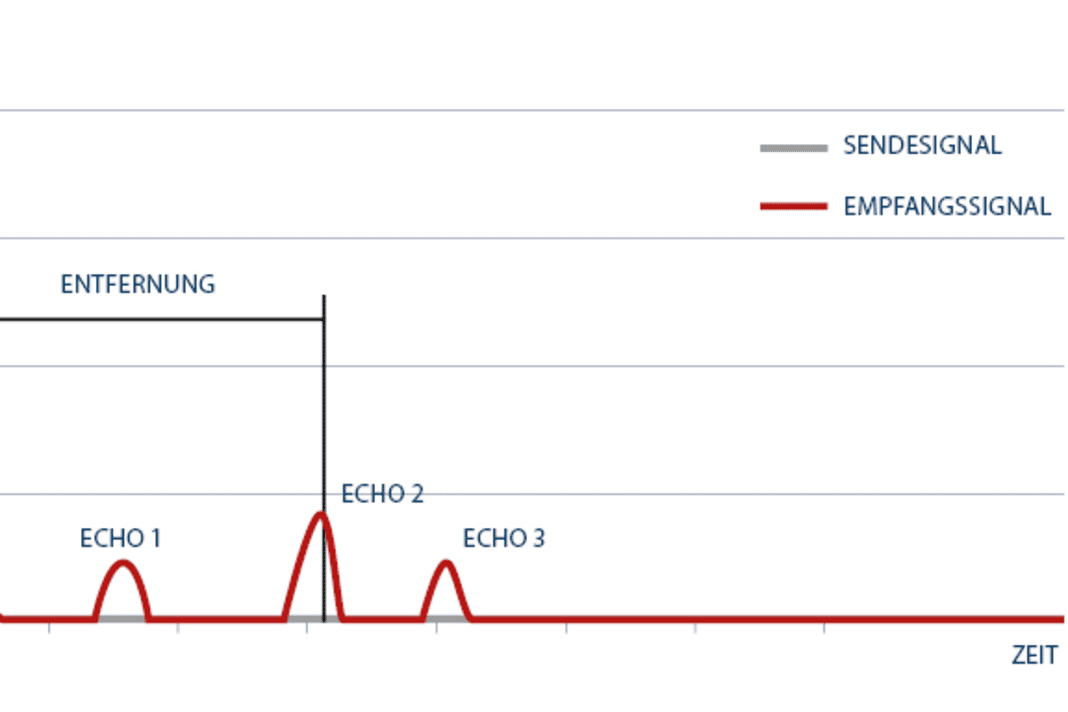



Raymarine Quantum 2
The second device in the test, which enables a WLAN connection between the antenna and display instead of the cable. However, this is optional here; the data cable is included. The wireless transmission itself was stable, but it often took two attempts to establish the WLAN connection when switching on the radar before it could be switched to transmit. Overall, the time required to switch on this solid-state radar was longer than the Furuno pulse radar, which is also connected via WLAN.
A network connection is also established between the "Off" and "Stand-by" radar operating states when connected via the supplied cable. However, this was always successful within 20 seconds.
When completely switched off, a consumption of two watts remains, so a separate switch should be provided on board. Raymarine has realised many functions in the Quantum, including automatic target detection for the Marpa (automatic target tracking) and various alarms for collision avoidance. The colour highlighting of objects that are approaching (red) or moving away (green) only works in the pure radar screen, not in the chart overlay. To switch between the radar presets for harbour, coast and sea, the map screen must be exited and the radar-only display called up, only then can the corresponding menu item be accessed.
Application
The same applies to accessing the adjustments for gain, sea state and rain haze. Switching from transmit to standby can always be carried out quickly using the power button; however, you can only switch back to transmit in the chart screen in the menu under "Targets". The scale and radar range are not linked in the map overlay. This is an advantage with this radar without dual range if several displays use the antenna: This means that the map zoom on one screen cannot unintentionally change the range of the radar operator on another screen.
This procedure is also advantageous when alarm zones or target tracking are used. If the selected map zoom and radar range do not match at all, this is quickly recognised by the block-shaped echoes; possibly also by the empty image, as the dead zone around the ship is quite large, in some range settings almost ten percent of the image. If you use the Quantum regularly and delve deeper into the menus, you will get very informative images.
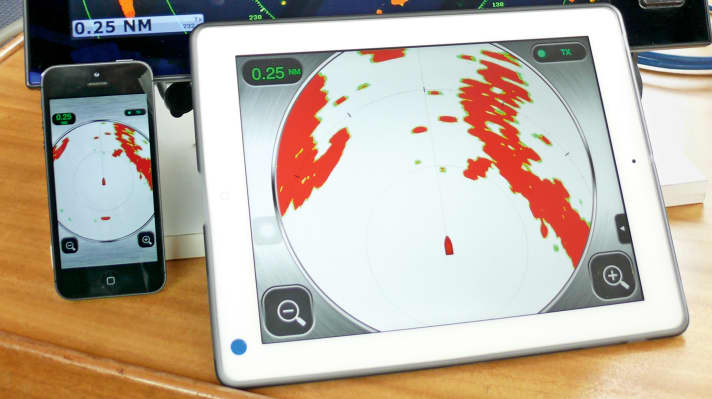
Conclusion
If you already own a plotter, you really have no choice but to buy the radar from the same manufacturer; the question of brand only arises with a complete system. And then the other features of the display, which are independent of the radar, are usually decisive. The Furuno device is the first choice for someone who does not want to or cannot deal with radar - there is nothing to adjust while travelling. It is also the only device that offers the option of adding radar to iPad navigation.
Fantom, Halo and Quantum differ in terms of figures, but are virtually on a par in terms of practical use for the skipper. The strengths here are the operation and the additional functions. Although Garmin's Fantom offers the best Doppler functions, they are no substitute for regular practice and attention when using a radar seriously.

